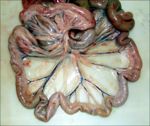Difference between revisions of "Jejunum - Anatomy & Physiology"
Jump to navigation
Jump to search
| Line 8: | Line 8: | ||
==Structure== | ==Structure== | ||
| + | [[Image:jejunumphoto.jpg|thumb|right|150px|Jejunum(Dog) - Copywright RVC 2008]] | ||
| + | *The jejunum is the longest part of the small intestine. | ||
| + | *It is highly coiled and occupies the ventral part of the abdominal cavity, filling those parts that are not occupied by other viscera. This produces species variation (see comparative aspects). | ||
| + | *It is suspended by the mesentry (mesojejunum). This conveys the blood vessels and nerves and houses lymph nodes. | ||
| + | **The mesentry converges to its root. This is where the cranial mesenteric artery branches off from the aorta. | ||
==Function== | ==Function== | ||
Revision as of 16:16, 7 July 2008
Introduction
Structure
- The jejunum is the longest part of the small intestine.
- It is highly coiled and occupies the ventral part of the abdominal cavity, filling those parts that are not occupied by other viscera. This produces species variation (see comparative aspects).
- It is suspended by the mesentry (mesojejunum). This conveys the blood vessels and nerves and houses lymph nodes.
- The mesentry converges to its root. This is where the cranial mesenteric artery branches off from the aorta.
